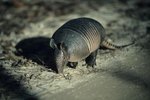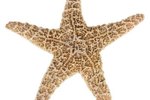
Five different classes of organisms make up the family Arthropoda; in total, they represent more than 90 percent of the world's living animal species. One of the oldest groups of animals, arthropods share a number of similar features that have allowed them to adapt to virtually every habitat in the world over the last 500 million years. For instance, all living arthropods have hard exoskeletons, jointed legs, bilateral symmetry and distinct body parts.
Hard Exoskeletons
Part of the reason that arthropods are so successful is their development of a tough exoskeleton. Composed of a very hard material called chitin, the resilience of the material helped to protect early arthropods from predators. Though they first evolved in the ocean, arthropods soon began to colonize the land, where their sturdy exoskeletons proved advantageous as well -- they provide support and structure for the animals’ bodies and reduced water loss. Chitinous exoskeletons come at a price, though -- they don't grow and, as such, arthropods must periodically shed their entire exoskeleton -- a process known as molting -- to accommodate their growing bodies. While waiting for their exoskeleton to regenerate and harden, arthropods are relatively defenseless.
Bilateral Symmetry
Many animals exhibit some form of symmetry, in which different portions of their bodies are mirror-images of each other. Arthropods are bilaterally symmetrical, meaning their left and right halves are mirror-images of each other -- humans, dogs, cats, fish and many other types of animals display bilateral symmetry. Many primitive animals, such as sponges, lack symmetry entirely; other animals, such as starfish and sea urchins -- a group of animals called the echinoderms -- exhibit radial symmetry, in which their bodies are symmetrical around a central point.
Segmented Bodies
Unlike most primitive animals, arthropods developed well-defined body parts early in their evolution. Primitive arthropods were heavily segmented, but among the current forms, many of the segments have become fused. The number and form of these segments is often helpful in distinguishing among major groups. For instance, arachnids have only two primary body parts, while insects have three.
Jointed Legs
Arthropods also have segmented legs. Legs typically occur in pairs, though some arthropods can autotomize their limbs and regenerate new ones when they molt. In part, the development of jointed legs allowed arthropods to develop strong exoskeletons, which provide great protection, but limit movement and flexibility. Ancestrally, each body segment after the head carried legs, but many arthropods have lost various sets of legs. The legs of some species -- such as millipedes -- are all largely similar, while others -- such as crayfish, lobsters and praying mantises -- possess specialized legs that perform different functions.
References
Photo Credits
-
PhotoObjects.net/PhotoObjects.net/Getty Images




